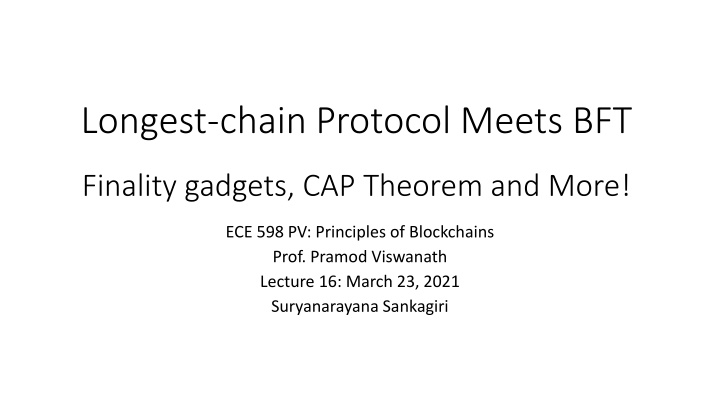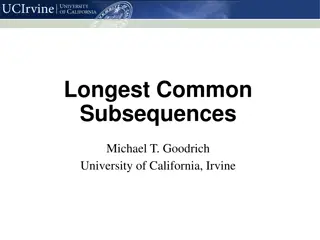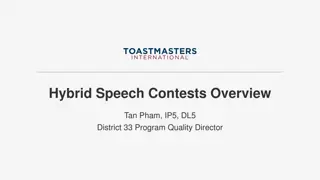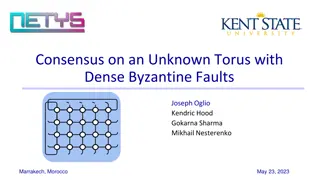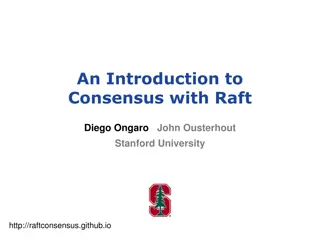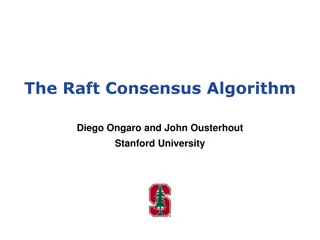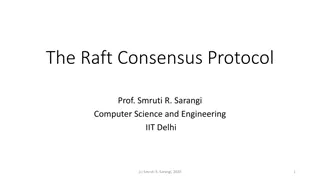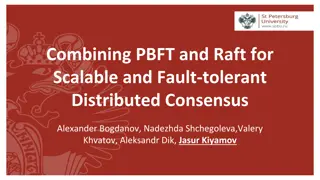Hybrid Consensus: Incorporating BFT into Longest-Chain Protocols
Today's lecture discussed the integration of BFT into longest-chain protocols, introducing new hybrid consensus models and finality gadgets. By combining HotStuff with PoW, the system aims to achieve fast transaction confirmation while maintaining decentralization and fairness in the committee election process.
Download Presentation

Please find below an Image/Link to download the presentation.
The content on the website is provided AS IS for your information and personal use only. It may not be sold, licensed, or shared on other websites without obtaining consent from the author.If you encounter any issues during the download, it is possible that the publisher has removed the file from their server.
You are allowed to download the files provided on this website for personal or commercial use, subject to the condition that they are used lawfully. All files are the property of their respective owners.
The content on the website is provided AS IS for your information and personal use only. It may not be sold, licensed, or shared on other websites without obtaining consent from the author.
E N D
Presentation Transcript
Longest-chain Protocol Meets BFT Finality gadgets, CAP Theorem and More! ECE 598 PV: Principles of Blockchains Prof. Pramod Viswanath Lecture 16: March 23, 2021 Suryanarayana Sankagiri
The Story So Far Safety: all parties have the same ledger Blockchain Protocols Liveness: the ledger keeps growing Longest-chain (Bitcoin): permissionless unsafe in asynchrony Two families BFT-style (HotStuff): permissioned safe under asynchrony TRADEOFFS!
Tradeoffs! Best of Both Worlds?
Todays Lecture Incorporating BFT into Longest-Chain Protocols New Protocols Hybrid Consensus Finality Gadgets Impossibility Results CAP Theorem Broader Perspective of Distributed Systems
Hybrid Consensus Longest-chain protocol is slow to confirm txns Can we have fast confirmation in a PoW permissionless system? Idea: Bring HotStuff to PoW for fast confirmation! Need decentralized, fair committee election
Hybrid Consensus public key pk8 pk1 pk2 pk3 pk5 pk6 pk7 pk9 pk10 pk4 committee Longest-chain protocol can serve as committee election mechanism A fool-proof, fair, decentralized method!
Hybrid Consensus Some finer details Can t stop mining! Adversary can upend longest chain if honest miners stop Committee overturned insecure protocol Chain quality matters! 1/3 mining adversary adversary in committee. Cannot tolerate! Need Fruitchains instead of Nakamoto consensus for ideal chain quality Susceptible to adaptive corruption Committee is all-powerful; block proposers are no longer unpredictable! Committee rotation protects against slow adaptive corruption
Hybrid Consensus What it achieves It achieves low confirmation latency in a PoW (permissionless) setting Where it fails asynchrony offline users ? > 1/3 loses safety stalls Needed for responsiveness Finality gadgets overcome these drawbacks
Towards Finality Gadgets What we desire A protocol that remains live and safe, despite variable participation PoW longest chain has this property longest chain should work, even if BFT component is turned on/off arbitrarily A protocol that remains safe, despite asynchrony BFT protocol has this property longest chain should work
Finality Gadget Layer-one: Proof-of-Work Longest Chain Two-layer design Layer-two: Committee-based BFT protocol Longest chain protocol produces and confirms blocks Works with variable participation k-deep rule remains viable BFT protocol independently confirms blocks Confirms the same set of blocks as produced by PoW! Switches on or off based on participation level
Finality Gadget Checkpoints block checkpointed by votes from BFT protocol blocks produced by PoW mining treat a checkpointed block as final fixed committee executes layer-two BFT protocol call them checkpointers
Rules of Checkpointing Checkpoint blocks on the same chain If not, safety violation! Checkpoint blocks on the longest chain If not, liveness violation! Checkpoint blocks close to the tip If not, checkpointing not of much use
More about Checkpointing Checkpointing protocol is a consensus engine Input values In theory: entire chain leading up to prospective checkpoint block In practice: hash of prospective checkpoint block Validity conditions Classical: if all honest users have same input, that input is finalized For gadgets: if all honest users have chains with a k-common prefix, then finalized block is on common prefix
Two-layer design does not work! Players must follow longest checkpointed chain rule period of asynchrony resume synchrony Extend the longest chain below the latest checkpoint block side-chain of blocks mined by adversary all miners mine here
Finality Gadget What it achieves Safety under asynchrony Faster confirmation? Requires confirming blocks at tip. [GRANDPA] Safety and liveness under variable participation? Requires confirming k-deep blocks. [Checkpointed Longest Chain, Ebb-and-Flow] Open problem: achieve all three properties
Finality Gadget Two Confirmation Rules Adaptive rule (k-deep rule) Remains live and safe under variable participation Requires synchrony for liveness and safety Finality-preserving rule (checkpoint-based rule) Remains safe under all conditions Is live only under synchrony and fixed participation Each rule generates its own ledger!
The Blockchain CAP Theorem No blockchain protocol can be adaptive and offer finality. [LR, 2020] C C C A A A offline users B B B D D D network partition protocol should stall online users should continue A decentralized protocol cannot distinguish between offline users and network partition
CAP Theorem in Blockchains Availability-favoring Consistency- favoring available during synchrony inconsistent Network partition INDISTINGUISHABLE TRADE-OFF available during full participation Dynamic participation consistent
The CAP Theorem Theorem: A distributed system cannot be both Consistent and Available during network Partitions (Brewer 2000, Gilbert & Lynch 2002) peer 2 peer 1 peer 2 peer 1 y x x x write y read write y x done client client Choose liveness or safety during network partition!
Going around the CAP Theorem Best-effort availability files in a data center Typically uses a consensus protocol in the back-end Best-effort consistency Web content No guarantee that the content retrieved is the latest
